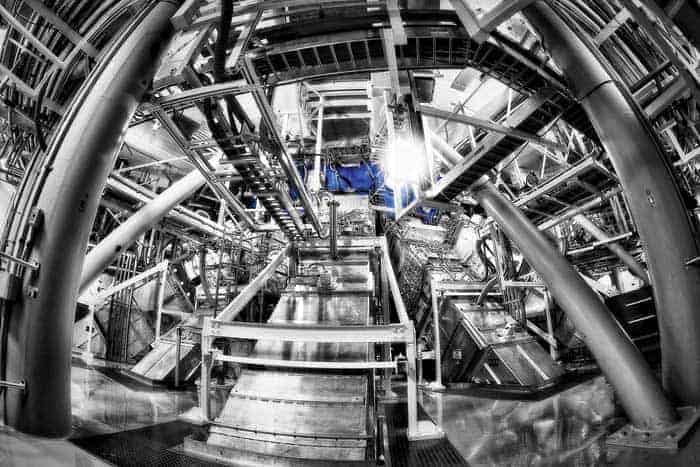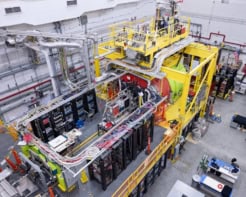
Physicists working at the National Ignition Facility (NIF) in the US say they have passed another important milestone in their quest for nuclear fusion energy. They have shown that the fusion energy generated by the laser implosion of a deuterium-tritium fuel capsule is twice that of the kinetic energy of the implosion. By further trebling the fusion energy, they say they will be close to the long-sought goal of an overall net energy gain.
The $3.5bn NIF trains 192 pulsed laser beams on to the inner surface of a centimetre-long hollow metal cylinder known as a hohlraum. Inside is a fuel capsule, which is a roughly 2 mm-diameter hollow sphere containing a thin deuterium-tritium layer. Each pulse lasts just a few nanoseconds and the lasers can deliver about 1.8 MJ of energy. This powerful blast causes the capsule to implode rapidly, creating immense temperatures and pressures inside a central “hot spot”, where fusion reactions occur.
The long-term goal is that the energy of neutrons given off by fusion can generate electricity. Before this is possible, NIF must show that it is possible to achieve ignition – the point at which fusion reactions generate at least as much energy delivered by the laser system. This involves self-sustaining reactions, in which the alpha particles that are also emitted during fusion give off enough heat to initiate further fusion.
High-footing it
After experiments done in 2009-2012 fell well short of ignition, Omar Hurricane and colleagues at NIF made significant changes to their strategy. They changed the shape of the laser pulses to create much more stable implosions. In 2014, these “high-foot” pulses each yielded up to 17 kJ of fusion energy (and later 26 kJ ) – exceeding the roughly 10 kJ created in earlier experiments.
Now, the team has modified the “high-foot” pulses and changed the composition of the outer layer of the capsules from plastic to carbon. The new material is three times as dense as the plastic, which means that laser pulses with a third of the duration can impart the same kinetic energy to implosions. Less helium gas is needed inside the hohlraum to prevent its walls from blowing in prematurely, which in turn makes for more stable implosions. And that means that more laser energy is ultimately converted into the kinetic energy of capsules’ collapse.
In 2017, the researchers obtained 54 kJ of fusion energy per laser pulse – as measured by the number of neutrons and alpha particles produced. This is twice the kinetic energy of the imploding capsules, which they established by measuring the implosion speed using X-ray radiography and by simulating the changing mass of the evaporating shell. In contrast, the 2014 experiments only just about recouped the kinetic energy.
Closer to the threshold
Team member Sebastien Le Pape says that the new experiments created a greater density and pressure within the hotspot and about twice as much heating by alpha particles. Although the latest energy output is less than a thirtieth of that needed for ignition, he points out that self-heating makes the fusion process highly nonlinear. What is crucial, he says, is generating a “burning plasma”, in which alpha particles dump more energy in the hot spot than is lost through radiation and electron conduction. Reaching this point, he estimates, will require a fusion energy of around 150 kJ. “We are much closer to that threshold than we were before,” he says.

The long road to ignition
The team is now using capsules and hohlraums with diameters about 10% larger than before. The larger capsules absorb more energy, which should make them collapse more quickly and generate more fusion reactions. Having carried out eight laser shots since January, he says the preliminary results look promising. “Nothing is telling us that we can’t make a burning plasma,” he says.
Le Pape believes a burning plasma could be achieved within two years if the group can solve additional engineering problems. As to how much longer it will then take to reach ignition, he refuses to speculate. “It is really hard to answer that question,” he says. “It depends on what challenges we find.”
Cautious enthusiasm
Fusion experts outside NIF are enthusiastic but remain cautious. Steven Rose of Imperial College London says that the research is “a significant advance on previous work at NIF,” arguing that although it remains to be seen how much higher the fusion output can be pushed, the group’s step-by-step approach is “plainly the right one”.
The University of Oxford’s Steve Cowley says that the group is “beginning to understand better how to control the asymmetries that have plagued NIF,” but points that even if it does achieve ignition “many more steps” will still be needed to turn fusion into a practical source of energy.
The research is described in Physical Review Letters.



